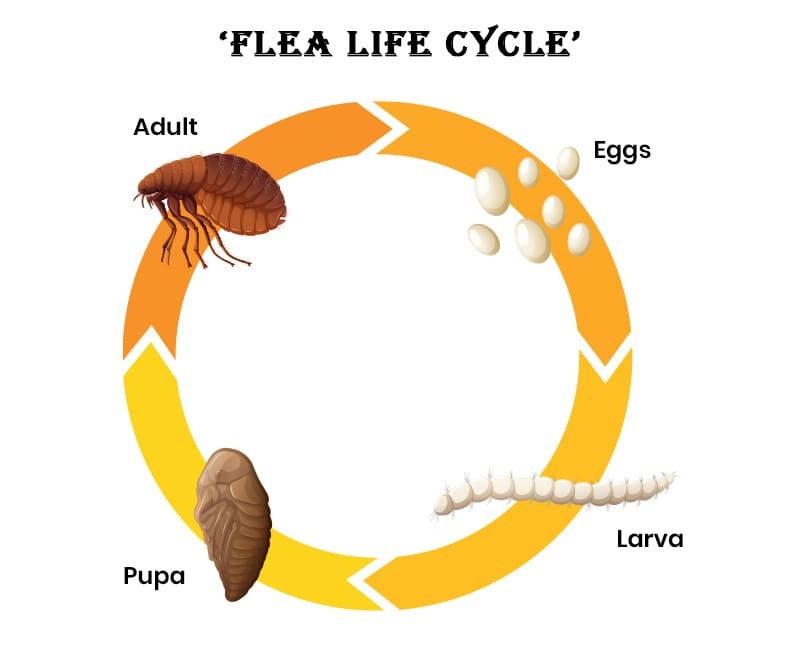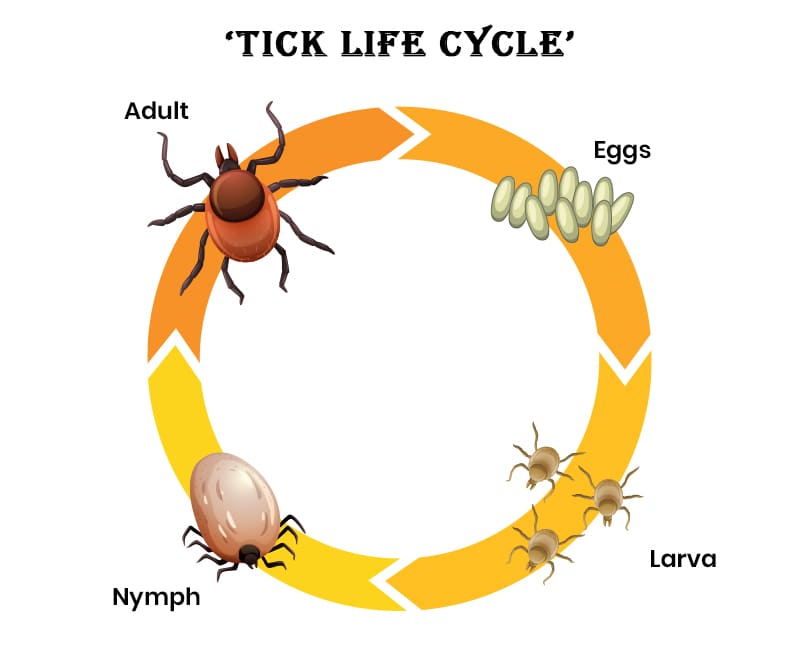
Fleas and ticks are some of the most menacing creatures that affect the health of our beloved canines. They easily find their way to a dog’s body, suck blood, and make them sick. While flea and tick infestations are very common during warmer months of the year, winter is not an exception. Fleas and ticks can survive the cold weather and can infect your furry buddy if they are not on proper treatments or preventives.
In this article, we will provide insights into the flea and tick life cycle, the diseases they cause, and how to protect your dog from flea and tick infestations.
Flea & Tick Life cycles and how they survive cold weather

A flea egg takes anywhere around 2 days to 2 weeks’ time for hatching at an ideal temperature above 70 degrees and can attain adulthood within two weeks to a few months’ duration depending on the surrounding environment. Flea eggs can lay dormant for months when the temperature is not suitable and can start the cycle again when the ideal environment is available. Though more sensitive than eggs, flea larvae can move. Larva can hide themselves and find food under the bedding and carpets to survive the harsh winters. Flea larva then reaches the pupa stage, which stays protected inside a cocoon and sticks to the carpet and bedding due to a glue-like substance. Pupa hatch and become an adult flea that takes meals on your furry companion’s blood and is capable of laying around 40-50 eggs per day. An adult flea can lay thousands of eggs during its lifetime.
The life cycle of a tick also consists of 4 stages:

A tick needs a blood meal from its host at every stage to grow. Hosts can be different for different stages. After feeding on a host, a female tick lays anywhere between 2000 to 4000 eggs usually during spring and around the area where its offspring can find their first host like deer or other animals. Come summer, and eggs hatch into larvae. Larva feed on a host, detach themselves, and keep growing during the fall and winter months, sheltering beneath leaf litter for warmth. By next springtime, larvae transition into nymphs and take another blood meal to ultimately transition into adult ticks by fall or winter. The adult ticks then take a blood meal from a host and mate. A male tick dies after mating with one or two females, while a female tick lays eggs after mating and dies soon after that.
Having an average lifespan of around 6 months and 2 to 3 years respectively, fleas and ticks are resilient parasites. Though the ideal temperature for fleas to flourish is between 70 to 85 degrees, these pests can survive as low as 33 degrees of temperatures for 5 subsequent days. When it comes to ticks, though highly active during late summer and early fall time, these blood-sucking pests can survive in winter temperatures as low as 32 degrees.
Flea and Tick induced diseases
Untreated flea and tick infestations can lead to serious illnesses or health conditions in your furry companion. Starting from skin allergies that can cause sores and infection, fleas can also transmit tapeworms to your pooch leading to weight loss and malnutrition in them. On the other hand, ticks can bring illnesses like Lyme disease and Rocky Mountain spotted fever. Brown dog ticks can transmit ehrlichiosis to your fur baby.
Why pet parents avoid year round-parasite protection
You may find fellow pet parents not using the parasite preventives for their pooches all year round. Though not advisable, this can be due to various reasons:
- Preventives are expensive– Flea and tick preventives cost high. Considering that the threat from these parasites is less in colder months, pet parents stop giving them to their canines and save some money. But if you look at the bigger picture, the trouble these parasitic infestations cause to your dog and the money that you spend on their treatment are much higher than what you spend on the preventives.
- Preventives are not safe- Many times; pet parents are reluctant to use the preventives regularly thinking that their continuous use can hurt their furry pal’s health. However, various researches have made it clear that these preventives are not harmful. Also, a flea and tick prevention regime prepared in consultation with a veterinarian is always going to be safe for your furry family member.
How to prevent flea and tick infestations
Taking these simple measures can help you keep these nasty parasites away from your pooch, not just in winter but all year round:
- The local environmental factors of the country impact the flea and tick population. Learn about flea and tick seasons in your surroundings to take the required actions.
- Groom your pooch regularly to find out whether they have caught any flea or tick infestation.
- Never get caught off guard. Keep your furry buddy protected year-round with a suitable flea and tick preventive. From monthly dosage to 8 months of protection and oral dosage to topical solutions, various flea and tick preventives are available in the market. Here are some of the best options you can select from:
- NexGard Chewables – protects dogs from flea and ticks for 1 month.
- Simparica Chewables – provides 35 days flea protection and controls tick infestations.
- Seresto Fleas & Ticks Collar – provides protection from fleas and ticks for 8 months.
To conclude
Fleas and ticks can hop on your dog very easily. Though the probability of catching flea and tick infestations during the hot summer months is higher, your furry family member is not fully protected from these parasites in comparatively colder winter months. It is therefore advisable to go for year-round parasite protection for the good health and safety of your pooch.